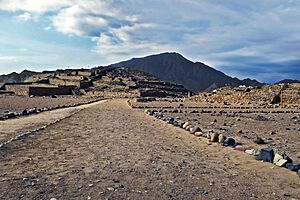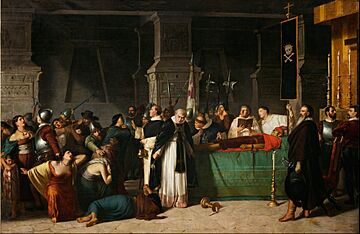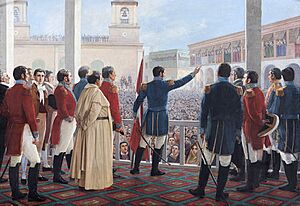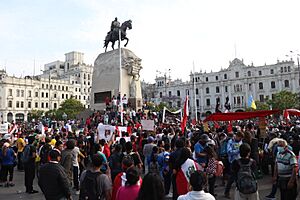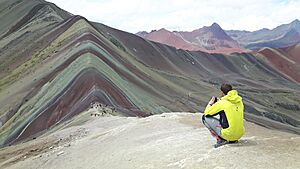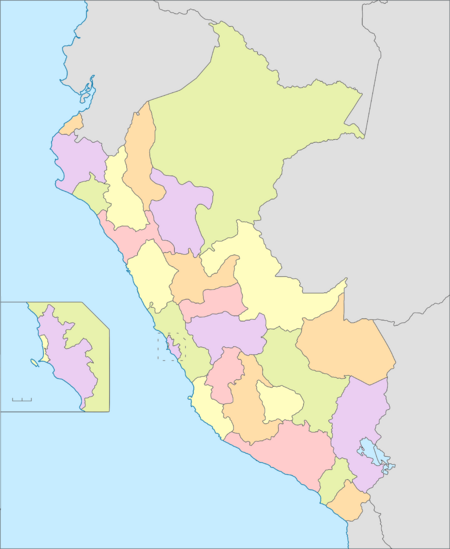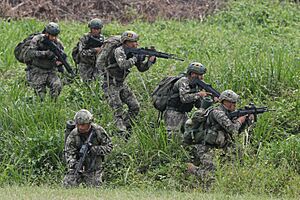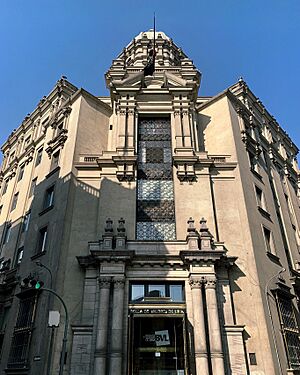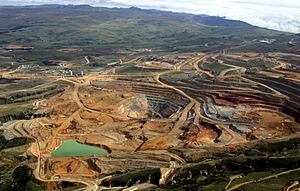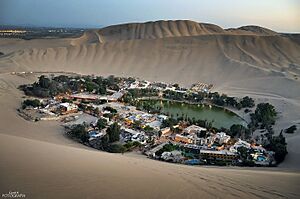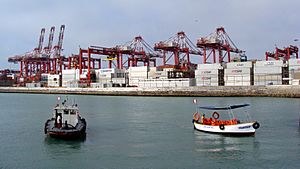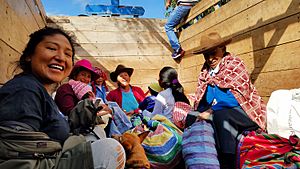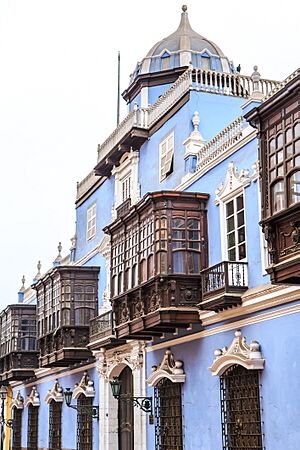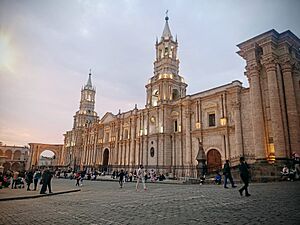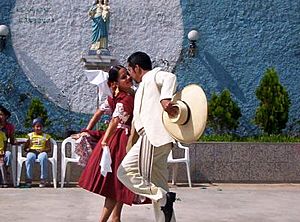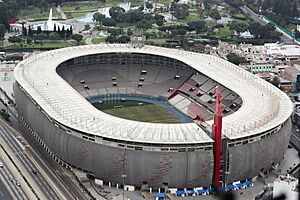Peru facts for kids
Quick facts for kids
Republic of Peru
|
|
|---|---|
|
Motto: "Firme y feliz por la unión" (Spanish)
"Firm and Happy for the Union" |
|
|
Anthem: "Himno Nacional del Perú" (Spanish)
"National Anthem of Peru" |
|
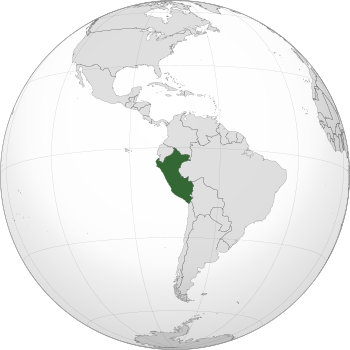
Location of Peru (dark green)
|
|
| Capital and largest city
|
Lima 12°2.6′S 77°1.7′W / 12.0433°S 77.0283°W |
| Official languages | Spanish |
| Co-official languages | |
| Ethnic groups
(2017)
|
|
| Religion
(2017)
|
|
| Demonym(s) | Peruvian |
| Government | Unitary semi-presidential republic |
| José Jerí | |
| Vacant | |
| Eduardo Arana Ysa | |
| Legislature | Congress of the Republic |
| Independence
from Spain
|
|
|
• Declared
|
28 July 1821 |
| 9 December 1824 | |
|
• Recognized
|
14 August 1879 |
| Area | |
|
• Total
|
1,285,216 km2 (496,225 sq mi) (19th) |
|
• Water (%)
|
0.41 |
| Population | |
|
• 2023 estimate
|
|
|
• Density
|
23/km2 (59.6/sq mi) (197th) |
| GDP (PPP) | 2025 estimate |
|
• Total
|
|
|
• Per capita
|
|
| GDP (nominal) | 2025 estimate |
|
• Total
|
|
|
• Per capita
|
|
| Gini (2022) | ▼ 40.2 medium |
| HDI (2023) | high · 79th |
| Currency | Peruvian sol (PEN) |
| Time zone | UTC−05:00 (PET) |
| Date format | dd/mm/yyyy (CE) |
| Driving side | right |
| Calling code | +51 |
| ISO 3166 code | PE |
| Internet TLD | .pe |
Peru, officially the Republic of Peru, is a country in western South America. It shares borders with Ecuador and Colombia to the north, Brazil to the east, Bolivia to the southeast, and Chile to the south. The Pacific Ocean lies to its south and west. Peru is a country with amazing natural variety. It has dry coastal plains, towering Andes mountains, and the tropical Amazon basin rainforest. The mighty Amazon River also flows through Peru.
Peru has a population of over 32 million people. Its capital and largest city is Lima. Covering about 1,285,216 square kilometers (496,225 sq mi), Peru is the 19th largest country in the world. It is also the third largest in South America.
The land of Peru has a very long history. It was home to many ancient cultures, some dating back to 10,000 BCE. The Caral–Supe civilization was one of the earliest in the Americas. Later, powerful groups like the Nazca culture, Wari Empire, and Inca Empire thrived here. The Inca Empire was the largest state in the Americas before Europeans arrived.
In the 16th century, the Spanish Empire conquered the region. They set up a large government area called the Viceroyalty of Peru. Lima became its capital. Peru declared independence from Spain in 1821. Its independence was fully secured after important battles in 1824.
After gaining freedom, Peru faced some challenges. But it also had times of economic growth, especially from selling guano (bird droppings used as fertilizer). In the 20th century, Peru saw more political changes and economic ups and downs. Today, Peru is a representative democracy with 25 regions. Its main economic activities include mining, manufacturing, agriculture, and fishing. Peru is known for its rich mix of cultures, seen in its art, food, and music.
What's in a Name?
The name "Peru" might come from "Birú." This was the name of a local leader who lived near the Bay of San Miguel in Panama in the early 1500s. Spanish explorers arrived in 1522. They thought this area was the southernmost part of the "New World." When Francisco Pizarro explored further south, the lands became known as "Birú" or "Perú."
Another story comes from the writer Inca Garcilaso de la Vega. He was the son of an Inca princess and a Spanish explorer. He said "Birú" was the name of a common person. This person was met by a ship's crew. The story shows how misunderstandings happened because people spoke different languages.
The Spanish government made the name official in 1529. They called the newly found Inca Empire the "province of Peru." Under Spanish rule, it was known as the Viceroyalty of Peru. After independence, it became the Peruvian Republic. In 1979, it adopted its current name, the Republic of Peru.
Peru's Past
Ancient Civilizations
Humans have lived in Peru for a very long time. The oldest signs of people date back about 12,500 BCE. Early societies in the Andes mountains focused on farming. They used smart methods like irrigation and terracing. Raising camelids (like llamas) and fishing were also important.
The Caral–Supe civilization was the oldest complex society in Peru. It thrived along the Pacific coast between 3,000 and 1,800 BCE. Later, other cultures developed. The Cupisnique culture (1000 to 200 BCE) was an early pre-Inca group.
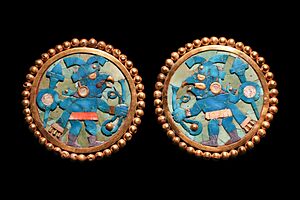
The Chavín culture (1500 to 300 BCE) was likely more about religion. Its main religious center was Chavín de Huantar. After Chavín declined, many smaller cultures appeared. These included the Paracas culture, Nazca culture, Wari culture, Chimú culture, and Moche culture.
The Moche people were skilled farmers and artists. They used irrigation to grow crops in dry areas. They made beautiful pottery and metalwork. The Chimú were great city builders. Their capital, Chan Chan, was made of adobe. The Tiwanaku Empire and Wari culture also built large cities.
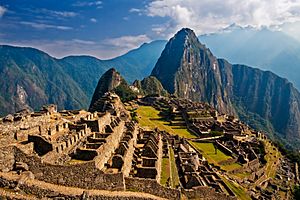
In the 1400s, the Inca Empire grew very powerful. They built the largest empire in the Americas before Europeans arrived. Their capital was Cusco. The Incas expanded their rule through conquest and peaceful agreements. They controlled most of the Andean region. Their empire stretched from Colombia to Chile.
The official language of the Inca Empire was Quechua. The Incas called their empire Tawantinsuyu, meaning "The Four Regions." They worshipped many local gods, but especially Inti, the sun god. Their king, the Sapa Inca, was seen as the "child of the sun."
Spanish Arrival and Rule
Atahualpa was the last Sapa Inca. He became emperor after winning a civil war. In 1532, Spanish explorers led by Francisco Pizarro captured Atahualpa. This was the start of the Spanish conquest. It took many years, but Spain eventually took control. They created the Viceroyalty of Peru, with Lima as its capital.
Many native people died from diseases brought by the Spanish. Others suffered from harsh labor. In the 1570s, Viceroy Francisco de Toledo reorganized the country. Gold and silver mining became the main economic activity. Native people were forced to work in the mines. Peru's silver and gold made Spain very rich.
Christianity also spread in South America. Most people were forced to become Catholic. Churches were built in every city. Some Inca temples were replaced by churches. Peruvian Catholicism often mixes native rituals with Christian celebrations.
By the 1700s, silver production slowed down. Spain made new laws to increase taxes and divide the viceroyalty. These changes led to revolts, like Túpac Amaru II's rebellion. But all were put down. Over time, Spanish settlers gained more control over the land.
Becoming Independent
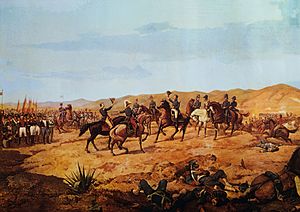
In the early 1800s, many South American countries fought for independence. Peru was a strong Spanish base. Its freedom came after military campaigns led by José de San Martín and Simón Bolívar.
Economic problems and Spain's weakening power helped independence ideas grow. But Peru's wealthy families often stayed loyal to Spain. The independence movement started in Argentina. José de San Martín led his army across the Andes mountains. He helped free Chile in 1818.
In 1820, San Martín arrived in Peru by sea. He tried to negotiate with the Spanish. But talks failed. The Spanish viceroy left Lima. On July 12, 1821, San Martín entered Lima. He declared Peru's independence on July 28, 1821. He also created the first Peruvian flag.
Simón Bolívar continued the fight from the north. He freed other areas like New Granada (now Colombia). In 1822, Bolívar and San Martín met. Bolívar took charge of freeing Peru completely. The Peruvian Congress named Bolívar dictator.
With help from Antonio José de Sucre, Bolívar's army defeated the Spanish. Key battles were Battle of Junín (1824) and Battle of Ayacucho (1824). These battles secured Peru's independence. After independence, Peru faced political challenges.
19th Century Changes
After independence, José de San Martín became the Protector of Peru. He created the National Library and ended the mita (forced labor for native people). He also set up the first government ministries.
From the 1840s to 1860s, Peru had a stable period. This was under President Ramón Castilla. The country earned a lot of money from exporting guano. In 1864, Spain tried to take over some islands. This led to a war between Peru and Spain. Peru, with help from Bolivia, Chile, and Ecuador, won this war in 1866.
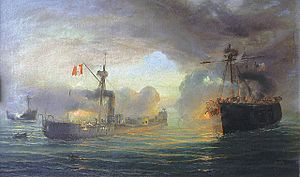
Peru used its guano money to modernize. Railways were built, and the government grew. Native people no longer had to pay tribute. Slavery was ended in 1854. People from Europe also moved to Peru.
In 1879, Chile declared war on Peru. This was the War of the Pacific. Bolivia was allied with Peru. The war was fought over valuable nitrate and guano lands in southern Peru. The Peruvian navy fought bravely. Admiral Miguel Grau became a national hero.
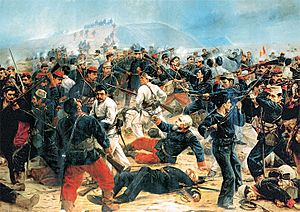
The war lasted almost five years. Peru lost some land, including the provinces of Tacna and Arica. After the war, Peru worked hard to rebuild. The country started social and economic reforms. Political stability returned in the early 1900s.
20th Century Events
After the War of the Pacific, Peru had a period of stability. But then, the authoritarian rule of Augusto B. Leguía began. The Great Depression caused his downfall. This led to more political problems. The American Popular Revolutionary Alliance (APRA) became important.
Peru and Ecuador fought a border war in 1941. The Rio Protocol later set the boundary. In 1948, General Manuel A. Odría became president. His time was known as the Ochenio. He was popular with the poor. But civil rights were limited, and corruption was common.
In 1968, General Juan Velasco Alvarado took power. His government aimed for "social progress." They took over foreign companies and reformed land ownership. Land was given to farmers. The Quechua language was made official. Peru tried to be more independent from other countries.
Later, President Alan García's policies caused economic problems. Inflation was very high. New money was introduced. Violent groups like Shining Path and Túpac Amaru Revolutionary Movement caused trouble.
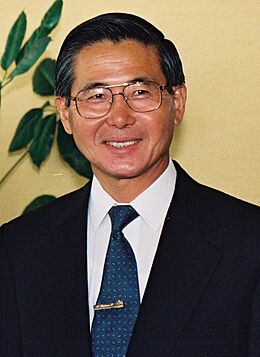
Alberto Fujimori became president in 1990. He made big economic changes. He ended price controls and opened the economy to foreign investment. He also cracked down on the violent groups. But his government was criticized for human rights issues. In 1995, Peru and Ecuador had another border conflict. A peace treaty was signed in 1998. In 2000, Fujimori resigned and left the country.
Peru in the 21st Century
In the early 2000s, Peru worked to fight corruption and grow its economy. Several presidents faced challenges. In 2009, former president Alberto Fujimori was sentenced to prison for human rights violations.
Recent presidents, like Ollanta Humala, Pedro Pablo Kuczynski, and Martín Vizcarra, faced political difficulties. Congress often challenged their actions. In 2018, Pedro Pablo Kuczynski resigned. Martín Vizcarra became president. He was popular for fighting corruption.
The COVID-19 pandemic hit Peru hard. It showed existing inequalities. Martín Vizcarra was removed from office by Congress in 2020. This led to protests. Manuel Merino briefly became president but resigned. Francisco Sagasti led a temporary government.
In 2021, Pedro Castillo was elected president. He faced many challenges from Congress. In December 2022, Castillo tried to dissolve Congress. But Congress quickly removed him from office. Dina Boluarte, the Vice President, became Peru's first female president. Castillo was arrested.
Boluarte's government faced protests. People wanted her and Congress to leave office. They also wanted new elections and a new constitution. Authorities responded to the protests, leading to violence.
Peru's Land and Climate
Geography of Peru
Peru is on the central western coast of South America. It faces the Pacific Ocean. The country is in the Southern Hemisphere. The Andes mountains run through Peru, parallel to the Pacific. They divide Peru into three main regions.
The costa (coast) is a narrow, dry plain in the west. It has valleys formed by seasonal rivers. The sierra (highlands) is the Andes mountain region. It includes the Altiplano plateau and Peru's highest peak, Huascarán, which is 6,768 meters (22,205 ft) tall. The third region is the selva (jungle). This is a large, flat area covered by the Amazon rainforest in the east. Almost 60% of Peru is in this jungle region.
Peru has 54 river basins. Most rivers start in the Andes. Rivers flowing to the Pacific are short and steep. Rivers flowing into the Amazon River are much larger and longer. The Amazon River, at 6,872 km (4,270 mi), is the longest river in the world. It covers 75% of Peru's land. Peru also has 4% of the world's freshwater.
The largest lake in Peru is Lake Titicaca. It is high in the Andes, shared with Bolivia.
Peru's Climate
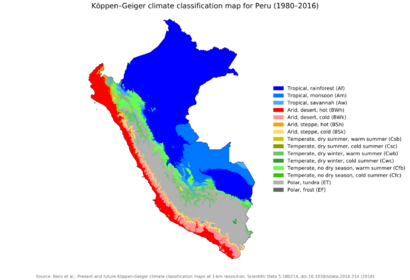
Even though Peru is in the tropics, it has many different climates. This is because of its mountains, varied land, and two ocean currents (Humboldt and El Niño). Peru has elevations from below sea level to over 6,700 meters (22,000 ft). Rainfall also varies greatly, from very little in deserts to a lot in rainforests.
Peru has three main climates:
- The coastal region has mild temperatures, low rain, and high humidity. The northern coast is warmer and wetter.
- The mountain region has frequent rain in summer. Temperatures and humidity drop as you go higher.
- The Peruvian Amazon has heavy rainfall and high temperatures. The southernmost part has cold winters and seasonal rain.
Wildlife of Peru
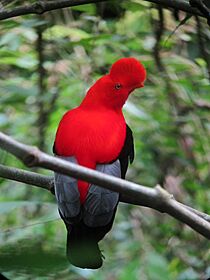
Peru has amazing biodiversity because of its varied geography and climate. As of 2003, it had 21,462 reported species of plants and animals. About 5,855 of these are found only in Peru. It is considered one of the world's "megadiverse" countries.
Peru is home to over 1,800 bird species, with 120 found only there. It also has over 500 mammal species. These include rare animals like the puma, jaguar, and spectacled bear. The Pacific Ocean off Peru has many fish, crustaceans, and shellfish. It is also home to sharks and whales.
Peru's plants are also very diverse. The coastal deserts have mostly cacti. But foggy oases and river valleys have unique plant life. The highlands above the tree-line, called puna, have bushes and drought-resistant plants. The Amazon rainforest is famous for its many trees and canopy plants.
Government and How Peru is Run
How Peru's Government Works
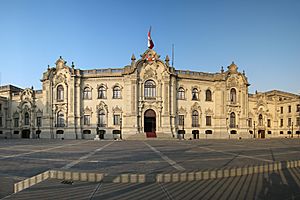
Peru is a republic with a semi-presidential system. This means it has both a president and a prime minister. The country has a liberal democracy based on its 1993 Constitution. Peru is a unitary state, meaning the central government holds most power.
The Peruvian government has three main parts:
- Legislature: This is the Congress of Peru. It has 130 members who make laws.
- Executive: This includes the president and the Council of Ministers. The president is both the head of state and head of government. The president appoints ministers, including the prime minister.
- Judiciary: This is the court system, led by the Supreme Court of Peru. It has judges who interpret laws.
The president of Peru is elected for a five-year term. They cannot be immediately re-elected. The president can ask Congress for a vote of confidence. If Congress refuses, the president can sometimes dissolve Congress. This happened in 1992 and 2019.

Congress members are also elected for five-year terms. They propose and vote on laws. Congress can also remove ministers or even the president from office. In recent years, Congress has removed several presidents.
Peruvians aged 18 to 70 must vote. Elections are organized by special national bodies. Peru has a multi-party system, meaning many political parties exist.
Regions of Peru
Peru is divided into 26 main areas. These are 24 departments, the Constitutional Province of Callao, and the Province of Lima. Lima Province is where the capital city is located.
Each department and Callao Province has an elected "regional" government. This government has a governor and a regional council. The governor leads the executive branch. The regional council makes laws and oversees officials. Both serve for four years. These governments plan local development and manage public projects.
Larger cities like Lima are run by a municipal council and a mayor. The goal of these local governments is to involve people more in decisions. Some areas are also called metropolitan areas. The Lima metropolitan area is one of the largest in the Americas.
Peru's Place in the World

Peru has strong relationships with the United States and Asia. It is part of groups like Asia-Pacific Economic Cooperation (APEC) and the World Trade Organization. Peru is also a founding member of the Andean Community of Nations. It is a member of the Organization of American States (OAS) and the United Nations. A famous Peruvian diplomat, Javier Pérez de Cuéllar, was the UN Secretary General from 1981 to 1991.
Peru is working to join the OECD (Organization for Economic Co-operation and Development). It has many free trade agreements with countries like the United States, China, and the European Union. Peru also works closely with other South American nations. It is part of the Pacific Alliance and Mercosur.
Peru has sometimes had tense relations with Chile. But both countries are working to improve things. Peru has also played a role in helping with the situation in Venezuela. According to the 2024 Global Peace Index, Peru is the 99th most peaceful country in the world.
Military and Police
Peru has a large military. The Peruvian Armed Forces include the Peruvian Navy, Peruvian Army, and Peruvian Air Force. Their main job is to protect Peru's independence and land.
Each branch has specific roles:
- The Peruvian Army is organized into military regions.
- The Peruvian Air Force protects the country's skies. It also helps people in hard-to-reach areas and during disasters.
- The Peruvian Navy protects Peru's waters.
The military is led by the president, the Ministry of Defense, and the Joint Command. Joining the military is voluntary since 1999. The National Police of Peru is separate from the military. It focuses on civilian law enforcement.
Since 2000, Peru has spent less on defense. The military is now also used for civil defense. For example, in 2020, military personnel helped enforce quarantine rules during the COVID-19 pandemic.
Peru's Economy
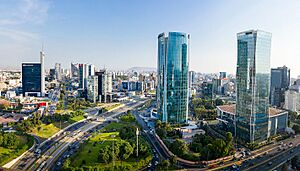
Peru's economy is the 48th largest in the world. The World Bank calls its income level "upper middle." Peru has been one of the fastest-growing economies in recent years. Its economic success is often linked to exports.
Historically, Peru's economy has relied on selling goods to other countries. This brings in money to buy imports and pay debts. In 2015, about 19.3% of Peru's population was poor. Inflation in 2023 was 8.6%. The unemployment rate in 2012 was 3.6%.
Peru's economic policies have changed over time. In the 1960s and 70s, the government took over many companies. It also reformed land ownership. These changes aimed to share wealth more fairly. But they didn't fully succeed.
In the 1990s, the government changed policies again. It ended price controls and welcomed foreign investment. This helped the economy grow. As of 2010, services make up 53% of Peru's economy. Manufacturing is 22.3%, and mining is 15%. Peru's main exports include copper, gold, zinc, textiles, and fish meal. Its main trading partners are the United States, China, Brazil, and Chile.
Many workers in Peru are in the informal sector. This means their jobs are not officially registered. In 2019, 70% of workers were in this sector.
Mining in Peru
Peru relies heavily on mining for its exports. In 2023, mining made up 61.3% of all exports. Peru is a major global producer of several minerals. In 2019, it was the world's second largest producer of copper and zinc. It was also the third largest producer of lead and the fourth largest of tin. In 2023, it was the third largest producer of silver.
The Yanacocha mine in Cajamarca is a huge source of gold. It is the largest gold mine in South America. Mining exports have grown a lot, from $1.4 billion in 1990 to $39.6 billion in 2023.
Farming in Peru
Peru is the world's largest producer of quinoa and maca. It is also one of the top 5 producers of avocado, blueberry, artichoke, and asparagus. Peru is among the top 10 producers of coffee and cocoa. It also grows a lot of potatoes, pineapple, grapes, and rice.
Despite its rich agriculture, many Peruvians face food insecurity. A 2022 report found that half of Peru's population doesn't always have enough food. This is due to high social inequality and low wages. Small farmers often suffer from hunger themselves.
Tourism in Peru
Tourism is Peru's third largest industry. It mainly focuses on ancient ruins and historical sites. Peru has over one hundred thousand archaeological sites. A government study found that 94% of tourists are happy after visiting Peru. Tourism is growing fast in Peru.
Tourism contributes 7% to Peru's economy. It creates many jobs in hotels and transportation. Peru is great for cultural trips, nature adventures, food tours, and beach vacations.
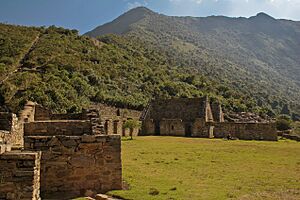
Popular places to visit include Lima and its historic center. Cusco is famous for its Inca and colonial buildings. Its main attractions are the Sacred Valley and Machu Picchu. Other famous sites in Cusco are Qorikancha and Ollantaytambo. Arequipa is also a big tourist spot, known for its historic center and the Colca Canyon. Puno is visited for Lake Titicaca.
Peru has 14 World Heritage Sites and 11 national parks. Other popular routes include the Mantaro River valley and the city of Trujillo. Trujillo is home to Chan Chan, the world's largest adobe city. Chiclayo, Piura, and Iquitos in the rainforest are also popular. In 2015, foreign tourist visits increased by 7%. This brought in $3.5 billion for Peru.
Industry in Peru
Peru's industry is the 50th most valuable in the world. In 2011 and 2016, Peru was the largest supplier of fishmeal. It is also the world's leading producer of alpaca wool. Peru is a major exporter of cotton clothing in Latin America. The country's natural resources also support a growing polymer industry. Peru is becoming an attractive place for businesses.
Getting Around and Services
Transportation in Peru
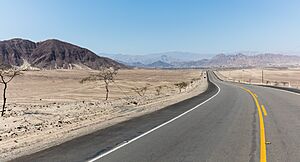
In 2021, Peru had 175,589 km (109,105 mi) of highways. About 29,579 km (18,380 mi) were paved. Important highways include the Pan American Highway and Interoceanic Highway. In 2016, Peru had 827 km (514 mi) of divided highways. The plan was to have 2,634 km (1,637 mi) by 2026. Peru's rail network is small, with 1,939 km (1,205 mi) of railways in 2018.
Peru has major international airports in Lima (Jorge Chávez), Cuzco (Alejandro Velasco Astete), and Arequipa (Rodríguez Ballón). Lima's Jorge Chávez International Airport is expanding. It will have a new runway, control tower, and terminal. This "Airport City" will handle 40 million passengers yearly. It was completed in December 2024. Another big airport project is the Chinchero International Airport in Cusco. This new airport will allow international flights directly to Cusco.
Peru has important ports in Callao, Ilo, and Matarani. The Port of Callao is currently the largest in Peru. But the new Port of Chancay will soon be the largest in Latin America. This port, a joint project with China, was officially opened on November 14, 2024. It is a key gateway for trade between South America and Asia.
Energy in Peru
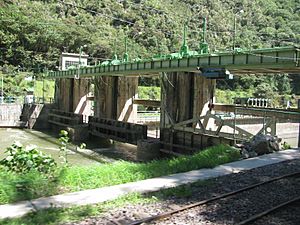
Peru's electricity sector has improved a lot. In 2016, 94.2% of homes had electricity, up from 82% in 2007. Electricity comes from both thermal (using oil, gas, coal) and hydroelectric (water power) sources. In October 2022, 52% of Peru's electricity came from hydroelectric plants. 38.3% came from thermal plants, and 9.7% from renewable sources like wind and solar.
In 2021, Peru had 5,490 MW of hydropower. It also had 409 MW of wind power and 336 MW of solar power.
Healthcare in Peru
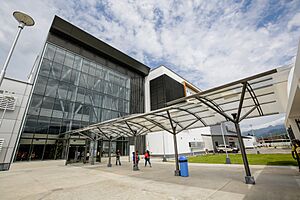
Life expectancy in Peru is about 75 years. Infant mortality has greatly decreased. The main causes of death are cancer, flu, pneumonia, and heart diseases. In 2017, 75.5% of Peruvians had some type of health insurance.
People of Peru
Population and Cities
Peru's population was estimated at over 33 million in 2022. It is the fourth most populated country in South America. About 58.8% of Peruvians live on the coast, 27% in the mountains, and 14.2% in the jungle. In 2020, 80% of Peruvians lived in cities.
Major cities include the Lima metropolitan area, with over 9.8 million people. Arequipa is the second largest city, and Trujillo is the third. There are also some uncontacted native tribes in Peru.
Many Peruvians have moved out of the country in recent decades. Over 10% of Peruvians now live abroad. The main destinations are the United States, Spain, Argentina, and Italy. Most are between 19 and 49 years old and move for work.
Peru has also received immigrants from Europe, Africa, and Asia throughout its history. Since 2016, many Venezuelans have moved to Peru. They are escaping economic problems in their home country. Peru is now home to the second largest number of Venezuelan immigrants.
Ethnic Groups
Racial groups in Peru (2017 census) Mestizo (60.20%) Indigenous (25.75%) White (5.89%) Black (3.57%) East Asian (0.16%) Others (4.42%)
Peru is a multiethnic nation. Its people come from many different backgrounds. Native Americans lived in Peru for thousands of years before the Spanish arrived. Their population greatly decreased after the Spanish conquest, mainly due to diseases.
The 2017 census asked people about their ethnic background. 60.2% identified as mestizo (mixed heritage). 22.3% identified as Quechua. 5.9% identified as white. 3.6% identified as black. 2.4% identified as Aymara. The rest identified as other groups or did not answer.
During Spanish rule, many Spaniards and Africans came to Peru. They mixed with the native population, especially on the coast. After independence, more Europeans came from Spain, Italy, and other countries. Chinese and Japanese people also arrived in the 1850s as workers. All these groups have influenced Peruvian society.
Languages Spoken
Peru's official languages are Spanish and, in areas where they are common, Quechua and other native languages. Spanish is spoken by 82.6% of the population. Quechua is spoken by 16.92%, and Aymara by 1.7%. Other native languages are spoken by 0.8%.
In cities, especially on the coast, most people speak only Spanish. In rural areas, many people speak more than one language. Spanish is used by the government, media, and in schools and businesses. Native people in the Andes speak Quechua and Aymara. There are also many different native languages spoken in the Amazon.
Efforts are being made to teach Quechua in public schools where it is spoken. In the Peruvian Amazon, languages like Asháninka and Bora are spoken.
Religion in Peru
Roman Catholicism has been the main religion in Peru for centuries. However, religious practices often mix with native traditions. In 2017, 76% of Peruvians over 12 identified as Catholic. 14.1% were Evangelical, and 4.8% were other Christian faiths, Jewish, or Jehovah's Witnesses. 5.1% said they had no religion. In 2025, naturalized Peruvian citizen Cardinal Robert Francis Prevost became Pope Leo XIV.
Native religious traditions are still important. Catholic holidays sometimes blend with native customs. Ancient Inca festivals, like Inti Raymi, are still celebrated. Most towns have their own church and patron saint. The two saints of Peru are Rose of Lima and Martin de Porres.
Education in Peru
Education in Peru is managed by the Ministry of Education. Education is required and free in public schools for initial, primary, and secondary levels. It is also free in public universities for students who do well and pass entrance exams. Most schools in Peru are private or religious. In 2007, Peru's literacy rate was 92.9%. It was lower in rural areas (80.3%) than in cities (96.3%).
Education starts with early childhood (ages 0-5). Primary education begins at age six and lasts six years. Secondary education lasts five years. After that, students can go to technical schools or universities. To enter a university, students usually need to pass an admission exam.
Peru has one of the oldest universities in the Americas. The National University of San Marcos was founded in 1551. It is known as one of the best universities in Peru and South America.
Peruvian Culture
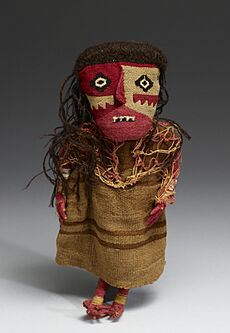
Peruvian culture is a mix of Spanish and Andean traditions. It also has influences from European, Asian, and African groups. Peruvian art traditions go back to ancient times. Early cultures made amazing pottery, textiles, jewelry, and sculptures. The Incas continued these crafts. They also built impressive structures like Machu Picchu.
During Spanish rule, Baroque art was popular. But it was changed by native traditions. Most art at this time was religious. The many churches and paintings from the Cusco School show this. After independence, art changed again. In the 20th century, the Indigenismo movement focused on native themes. Today, Peruvian art is a mix of different styles.
Peruvian Food
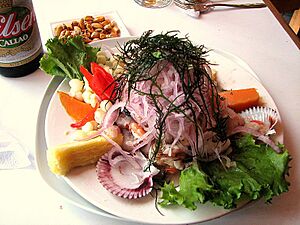
When Spanish explorers came to America, they found new foods. These included potatoes, tomatoes, and maize (corn). These foods were then shared with the rest of the world. Today, Peru grows over 3,000 kinds of potatoes.
Modern Peruvian cuisine mixes native and Spanish foods. It also has strong influences from Chinese, African, Arab, Italian, and Japanese cooking. Common dishes include anticuchos (skewered meat), ceviche (marinated seafood), and pachamanca (food cooked in an earth oven). Peru is known for having one of the best cuisines in the world. Lima, the capital, has famous restaurants like Central Restaurante. They serve dishes from all parts of Peru: the coast, mountains, and rainforest.
Peruvian food uses local ingredients. Immigrants adapted their traditional recipes using what was available in Peru. Foods like quinoa, kiwicha, and chili peppers have become very popular again. This shows a renewed interest in native Peruvian foods and cooking methods.
Music of Peru
Peruvian music has roots in Andean, Spanish, and African traditions. Before Europeans arrived, different regions had their own music. The quena (flute) and tinya (drum) were common instruments. Spaniards brought new instruments like the guitar and harp. This led to new instruments like the charango (a small stringed instrument). African influences brought new rhythms and the cajón (a box drum).
The charango is a very important instrument in Peru. It was created during colonial times. It was once seen as an instrument of the poor. But after a revolution in 1959, it became more popular. Other instruments like violins and harps are also played. The pan flute, dating back to Inca times, is very famous in the Peruvian Andes.
Peru also has popular rock and pop singers and bands. Some have won international awards. Los Saicos is considered one of the first garage rock bands in the world. Other famous Peruvian rock bands include Arena Hash and Nosequien y Los Nosecuantos.
Movies in Peru
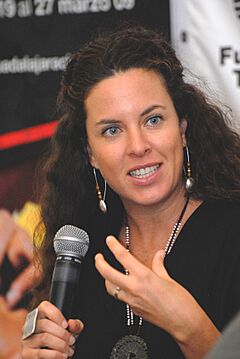
Peru's film industry is not as big as some other Latin American countries. But some Peruvian movies have been successful. Early cinema in Peru started in Iquitos in 1932. This was during the rubber boom.
Peru also made the first 3-D animated film in Latin America, Piratas en el Callao. This movie is about the historic port city of Callao. It shows how the city defended itself from attacks long ago.
The film Madeinusa (2006), directed by Claudia Llosa, won an award at the Rotterdam Film Festival. Llosa's second film, The Milk of Sorrow, was nominated for an Academy Award. It also won the Golden Bear at the Berlin Film Festival.
Sports in Peru
Sports in Peru date back to the 16th century. The Peruvian Sports Institute (IPD) oversees sports in the country. Peru's largest stadium is Estadio Monumental "U", which holds over 80,000 people. The national stadium is the Estadio Nacional. Peru has hosted major sporting events, like the 2004 Copa América and the 2019 Pan American Games. The national sport of Peru is Paleta frontón.
Football (soccer) is the most popular sport. The Peruvian Primera División is the top club tournament. The men's team has played in the FIFA World Cup five times. They have also won the Copa América twice, in 1939 and 1975. Teófilo Cubillas is considered Peru's greatest footballer.
Other popular sports include volleyball, surfing, and karate. Peru has won many medals at the Pan American Games. The Peru women's national volleyball team was very strong in the 1980s and 90s. They won a silver medal at the 1988 Summer Olympics.
Images for kids
See also
 In Spanish: Perú para niños
In Spanish: Perú para niños





